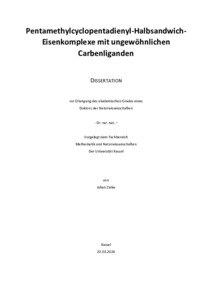| dc.date.accessioned | 2024-05-07T14:30:10Z | |
| dc.date.available | 2024-05-07T14:30:10Z | |
| dc.date.issued | 2024 | |
| dc.identifier | doi:10.17170/kobra-2024042910100 | |
| dc.identifier.uri | http://hdl.handle.net/123456789/15744 | |
| dc.language.iso | ger | |
| dc.rights | Attribution-NonCommercial-NoDerivatives 4.0 International | * |
| dc.rights.uri | http://creativecommons.org/licenses/by-nc-nd/4.0/ | * |
| dc.subject | Halbsandwich-Eisenkomplexe | ger |
| dc.subject | Eisen-Carben-Komplexe | ger |
| dc.subject | Ferrocen | ger |
| dc.subject.ddc | 540 | |
| dc.title | Pentamethylcyclopentadienyl-Halbsandwich-Eisenkomplexe mit ungewöhnlichen Carbenliganden | ger |
| dc.type | Dissertation | |
| dcterms.abstract | This dissertation project deals with the electronic properties of the pentamethylcyclopentadienyl halfsandwich iron complex with bis(trimethylsilyl)amido ligand ([Fe(Cp*)(HMDS)], HMDS = N(SiMe₃)₂) and its reactivity towards carbenes or their direct precursor compounds. The compound was published in 1998 by the Siemeling group and described at the time as diamagnetic. Structurally very similar representatives with penta-isopropylcyclopentadienyl- (⁵Cp) and 1,2,4-tri-tert-butylcyclopentadienyl ligands (Cp‘) have been found to be paramagnetic with four unpaired electrons (S = 2 ). Such an electronic configuration has now also been confirmed for [ Fe(Cp*)(HMDS)] u sing ⁵⁷Fe Mössbauer spectroscopy and SQUID magnetometry. For investigations of the reactivity of [Fe(Cp*)(HMDS)] towards formamidinium salts, the precursors of diaminocarbenes, two new formamidinium salts and their corresponding N-heterocyclic carbenes with 1,1’-ferrocenylene backbone (fcNHCs) were synthesized and characterized. To achieve this, the formamidinium salts with trimethylbenzyl and benzyl substituents, fc(NCH₂Mes)₂C·H[BF₄] (Mes = C₆H₂- 2,4,6-Me₃) and fc(NCH₂Ph)₂C·H[BF₄], were deprotonated with LiHMDS. In the case of fc(NCH₂Mes)₂C·H[BF₄], the corresponding carbene fc(NCH₂Mes)₂C was isolated in crystalline form; however, fc(NCH2₂Ph)₂C is not thermally stable but could be identified through trapping reactions, resulting in the corresponding selenourea and thiourea as well as a ligand in various complexes. Known and newly synthesized formamidinium salts fcNHC·H[BF₄] showed no reaction with [Fe(Cp*)(HMDS)]. Only after the addition of a halide source did a reaction occur, which can be understood as deprotonation of the formamidinium cation by the iron amide. Therefore, [Fe(Cp*)(HMDS)] was first reacted with tetra-n-propylammonium halides ([NⁿPr₄]X) to form complexes of t he t ype [ NⁿPr₄][FeX(Cp*)(HMDS)], which then reacted with the formamidinium salts to form complexes of the type [FeX(Cp*)(fcNHC)]. The reaction of N,N-dimethylbenzimidazolium iodide (Me₂BzIm·HI) with [Fe(Cp*)(HMDS)] yielded [FeI(Cp*)(Me₂BzIm)] and [Fe(Cp*)(Me₂BzIm)₂][FeI₂(Cp*)] as isomeric products in equilibrium with each other. In the course of preparing anions of the type [FeX(Cp*)(HMDS)]−, a synthesis of the simple and previously unknown anions of the type [FeX₂(Cp*)]− was developed from labile [FeX(Cp*)] and [NnPr₄]X, thus providing a storable source of [FeX(Cp*)]. (Benz)imidazolium-benzimidazolates (HL) exist in tautomeric equilibrium with carbenes and are suitable ligands due to their carbene functionality and their nitrogen functionalities, making them of interest to the Siemeling group. Reactive C,N-chelate complexes of the type [Fe(Cp*)L] were obtained by reaction with [Fe(Cp*)(HMDS)]. These were identified and characterized in the form of several complexes of the type [Fe(Cp*)(L)(CO)] as well as the dinitrogen-bridged dinuclear complex [Fe(Cp*)(L₅)]₂(μ-N₂) (HL₅ = N-isopropylbenzimidazolium-benzimidazolate). | eng |
| dcterms.abstract | Dieses Dissertationsprojekt befasst sich mit den elektronischen Eigenschaften des 1998 von der Arbeitsgruppe Siemeling publizierten und seinerzeit als diamagnetisch beschriebenen Pentamethylcyclopentadienyl-Halbsandwich-Eisenkomplexes mit Bis(trimethylsilyl)amido-Liganden ([Fe(Cp*)(HMDS)], HMDS = N(SiMe₃)₂) und dessen Reaktivität gegenüber Carbenen bzw. deren direkten Vorläuferverbindungen. Strukturell sehr ähnliche Vertreter mit Pentaisopropylcyclopentadienyl- (⁵Cp) und 1,2,4-Tri-tert-butylcyclopentadienyl-Liganden (Cp‘) erwiesen sich mitlerweile als paramagnetisch mit vier ungepaarten Elektronen (S = 2). Eine solche elektronische Konfiguration konnte mitels ⁵⁷Fe-Mößbauerspektroskopie und SQUID-Magnetometrie nun auch für [Fe(Cp*)(HMDS)] bestätigt werden. Für Untersuchungen zur Reaktivität von [Fe(Cp*)(HMDS)] gegenüber Formamidiniumsalzen, den Vorstufen von Diaminocarbenen, wurden zwei neue Formamidiniumsalze und deren korrespondierende N-heterocyclische Carbene mit 1,1’-Ferrocenylen-Rückgrat (fcNHCs) synthetisiert und charakterisiert. Hierzu wurden die Formamidiniumsalze mit Trimethylbenzyl- und Benzyl- Substituenten, fc(NCH₂Mes)₂C·H[BF₄] (Mes = C₆H₂-2,4,6-Me₃) und fc(NCH₂Ph)₂C·H[BF₄], mit LiHMDS deprotoniert. Im Falle von fc(NCH₂Mes)₂C·H[BF₄] wurde das korrespondierende Carben fc(NCH₂Mes)₂C in kristalliner Form isoliert; fc(NCH₂Ph)₂C ist hingegen thermisch nicht stabil, ließ sich aber durch Abfangreaktionen nachweisen, und zwar in Form des korrespondierenden Seleno- und Thioharnstoffs sowie als Ligand in diversen Komplexen. Bekannte und neu dargestellte Formamidiniumsalze fcNHC·H[BF4] zeigten keine Reaktion mit [Fe(Cp*)(HMDS)]. Erst nach Zugabe einer Halogenid-Quelle fand eine Reaktion stat, die als Deprotonierung des Formamidinium-Kations durch das Eisenamid verstanden werden kann. Daher wurde [Fe(Cp*)(HMDS)] zunächst mit Tetra-n-propylammoniumhalogeniden ([NⁿPr4]X) zu Komplexen der Art [NⁿPr₄][FeX(Cp*)(HMDS)] umgesetzt, die dann mit den Formamidiniumsalzen zu Komplexen der Art [FeX(Cp*)(fcNHC)] reagierten. Die Reaktion von N,N-Dimethylbenzimidazoliumiodid (Me₂BzIm·HI) mit [Fe(Cp*)(HMDS)] ergab [FeI(Cp*)(Me₂BzIm)] und [Fe(Cp*)(Me₂BzIm)2][FeI₂(Cp*)] als miteinander im Gleichgewicht stehende isomere Produkte. Im Zuge der Darstellung der Anionen des Typs [FeX(Cp*)(HMDS)]− wurde eine Synthese der simplen und bisher nicht bekannten Anionen des Typs [FeX₂(Cp*)]− aus labilem [FeX(Cp*)] und [NnPr₄]X entwickelt und somit eine lagerbare Quelle von [FeX(Cp*)] dargestellt. (Benz-)Imidazolium-Benzimidazolate (HL) stehen in Tautomerie mit Carbenen und eignen sich sowohl aufgrund ihrer Carbenfunktionalität als auch ihrer Stickstofffunktionalitäten als Liganden, und in diesem Zusammenhang sind sie für die Arbeitsgruppe Siemeling von Interesse. Durch Reaktion mit [Fe(Cp*)(HMDS)] wurden reaktive C,N-Chelatkomplexe vom Typ [Fe(Cp*)L] erhalten. Diese wurden in Form mehrerer Komplexe des Typs [Fe(Cp*)(L)(CO)] sowie des Distickstoff-verbrückten Zweikern- Komplexes [Fe(Cp*)(L₅)]₂(μ-N₂) (HL₅ = N-Isopropylbenzimidazolium-Benzimidazolat) nachgewiesen und charakterisiert. | ger |
| dcterms.accessRights | open access | |
| dcterms.creator | Zinke, Julian | |
| dcterms.dateAccepted | 2024-03-20 | |
| dcterms.extent | XI, 227 Seiten | |
| dc.contributor.corporatename | Kassel, Universität Kassel, Fachbereich Mathematik und Naturwissenschaften, Institut für Chemie | |
| dc.contributor.referee | Siemeling, Ulrich (Prof. Dr.) | |
| dc.contributor.referee | Sitzmann, Helmut (Prof. Dr.) | |
| dc.contributor.referee | Backes, Claudia (Prof. Dr.) | |
| dc.contributor.referee | Pietschnig, Rudolf (Prof. Dr.) | |
| dc.subject.swd | Metallorganische Chemie | ger |
| dc.subject.swd | Ferrocen | ger |
| dc.type.version | publishedVersion | |
| kup.iskup | false | |
| ubks.epflicht | true | |


